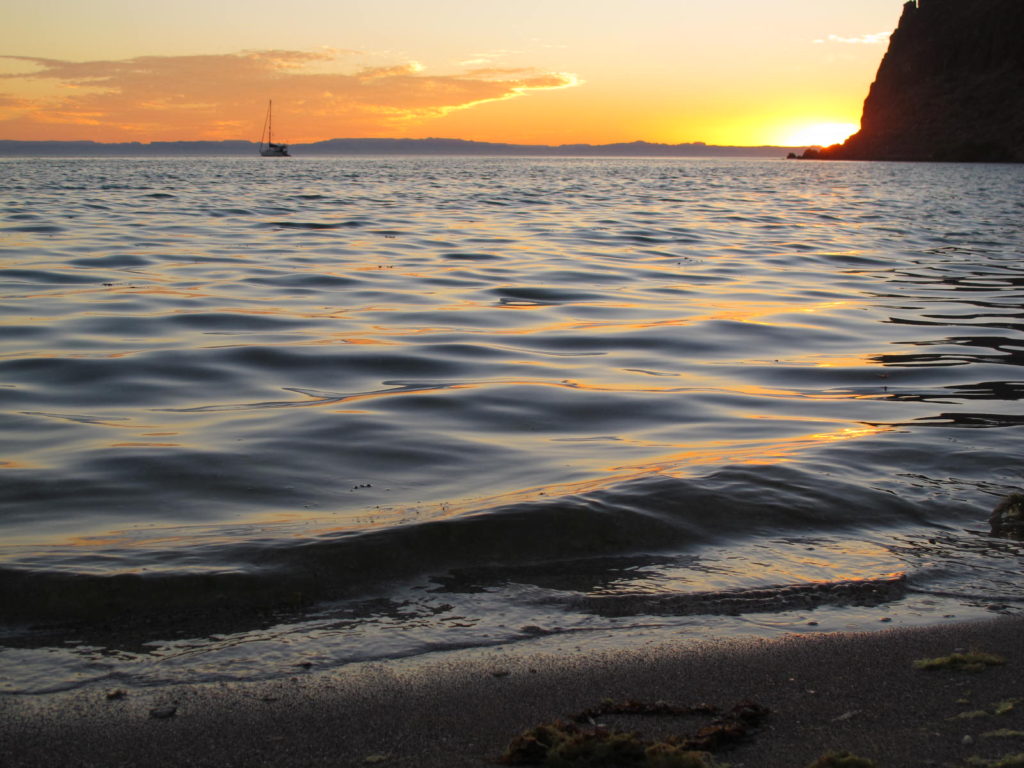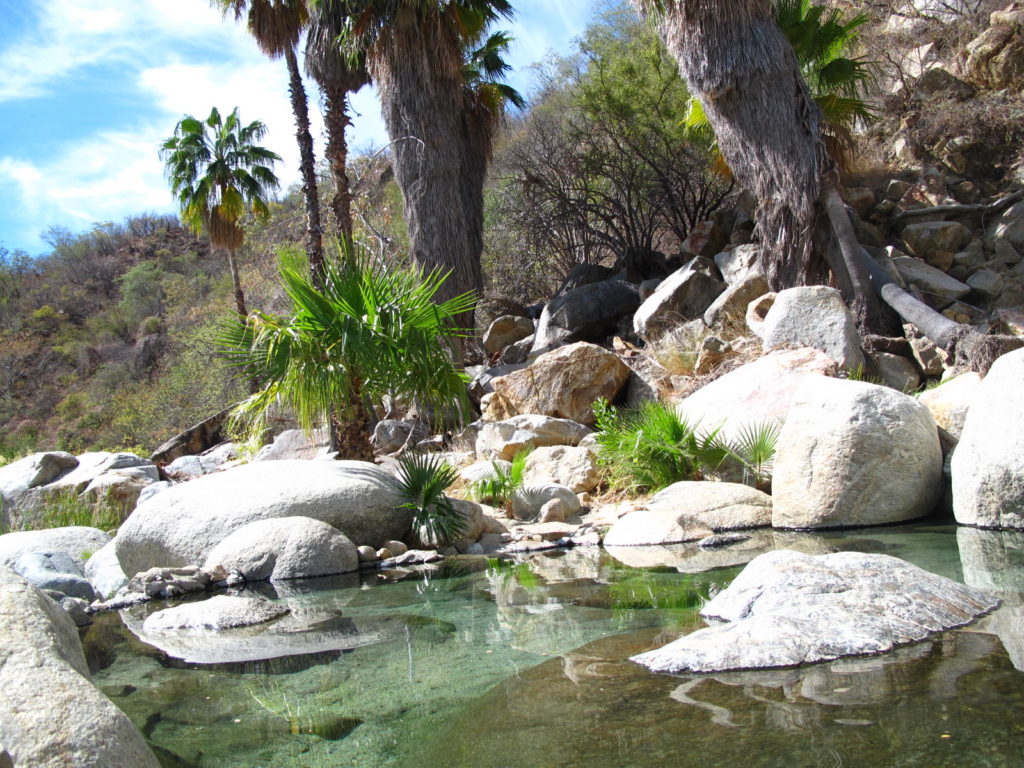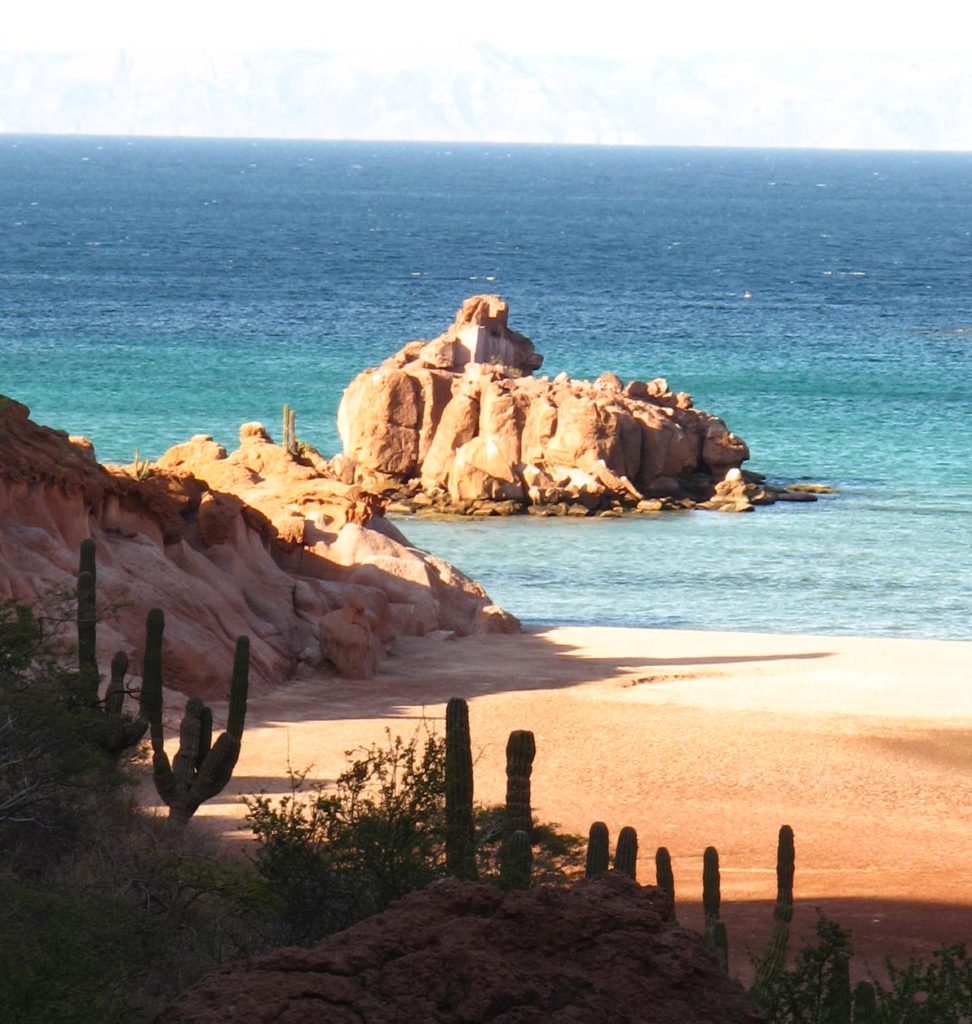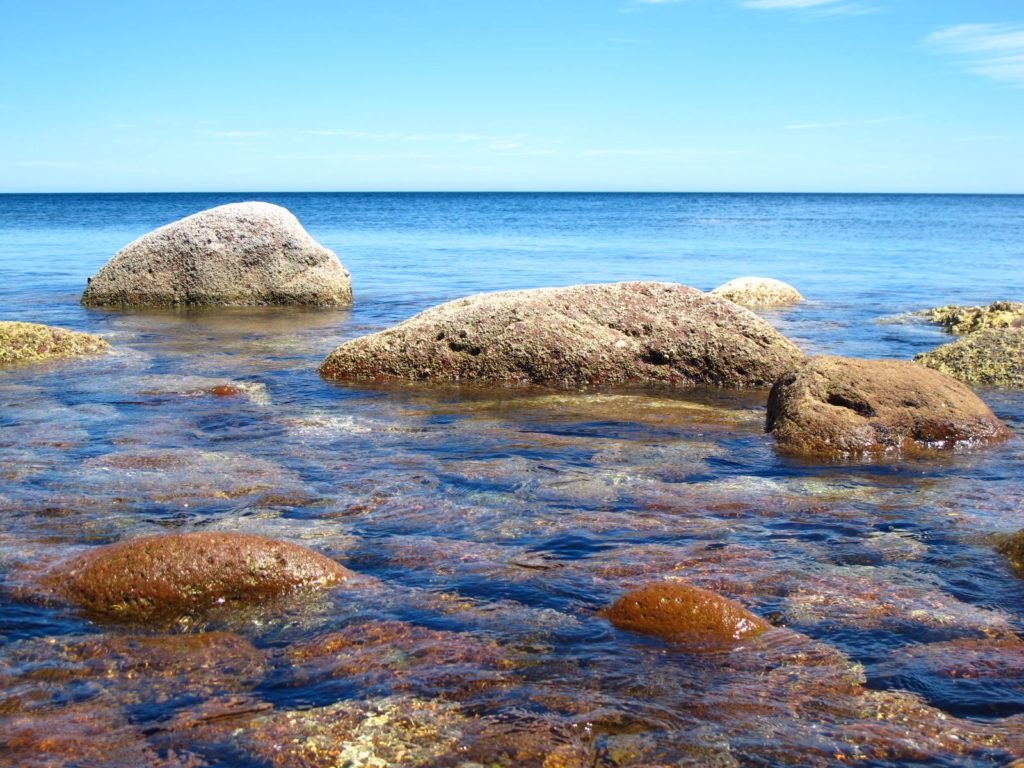Over chelas and seafood tacos, my husband and I soaked in the last rays of the sunset along the Malecón’s waterfront in La Paz, Baja California Sur. We’d just returned from three nights of camping on the Isla Espíritu Santo, just north of the peninsula that juts out into the Sea of Cortés. We laughed until we cried, recalling the exploits of the various crew members, guides, and campers we’d met over the previous few days.
With a start, my husband realized that his credit card was missing.
As he ran through places where he might have lost it, he last remembered having it at this restaurant, right before leaving on the camping trip. Figuring it was a lost cause, he sheepishly approached the cashier. Sure enough, he’d left it behind. They’d held it safe and sound for the four days we were gone, returning it to him with a mix of gentle teasing and professional dignity.
As it turned out, this scene was a pretty perfect illustration of the singular beauty of Mexico and its people. Milagro–Spanish for “miracle”–became the watchword for our trip.
In light of the ugly rhetoric from certain quarters, it bears repeating that Mexico is a fascinating, beautiful place, rich with history and culture. This after all is a country that puts the poetry of a seventeenth-century proto-feminist nun on its currency. And where 68 additional languages besides Spanish are officially recognized. And is the homeland of such delicacies as corn, chile, and chocolate.
When we’d first considered a spring trip as an antidote to the unrelenting wet of this winter, I wasn’t excited about Baja California. Mexico, sure, but Baja? Wasn’t that just some place filled with drunk gringos?
Although you can certainly find that scene in Baja, happily it’s easy to escape.
We flew in to San José del Cabo, then headed north to La Paz for a three-night camping trip with a company called Baja Expeditions. (We both agreed that “glamping” might be a better term for the experience, particularly where camp food was involved. Our cook’s meals, including the multi-course breakfasts and the nightly happy hour, were certainly an improvement over our own sorry efforts at feeding ourselves in the wilderness.) Isla Espíritu Santo might be an eco-reserve, but this is still Mexico. Food matters.
Jacques Cousteau famously referred to the Sea of Cortés as the “aquarium of the world,” and somehow, despite humanity’s attempts to impose “progress” on every corner of the planet, the golfo remains a wild and lovely place, teeming with life. It brought to mind a phrase I’ve heard in the context of Alaska: “life responds to life.” Humans, biophiliacs that we are, respond to the whale sharks, the sea lions, the devil rays, the innumerable birds, the nocturnal pranks of the babisuri, the stark beauty of the cactus.
And not unlike Alaska, Baja is a place of extremes: heat, cold, aridity, distance. For all the grace of a softly lit beach at twilight, the desert is forbidding and not lacking in danger. The desert, like the wild forests of the northern Pacific, commands your attention and holds it in full.
This full engagement with the natural world is, of course, the biophiliac’s drug of choice, and it’s why they flock to Baja.

Isla Espíritu Santo was pristine, and the camps seemed well managed. And yet, everyone we talked to mentioned that there were more people than ever visiting the area, swimming with the whale sharks and sea lions and devil rays, kayaking through sea caves, star gazing from sandy beaches. Small boats jostled one another at the prime attractions, their captains shouting friendly greetings and reminders of the procedural rules.
Tourism brings revenue and revenue brings, among other things, incentives for ecological preservation. As always, though, one wonders about the long-term costs of increasingly intensive human activity in a sensitive landscape, even when you’re talking about eco-tourism or, as Bajans call it, “alternative tourism.” What are the upper limits of the region’s carrying capacity for tourism? When do these needs begin to edge out the concerns of the people who live in the region–and why should tourists get all the goodies?
These concerns filtered into many of our conversations with many of the Mexican guides, landowners, and tour operators we spoke to. One ejidatario, a landowner in Mexico’s system of collective land-use known as ejidos, told us about how the people in his town had banded together to maintain control over their local water supply, rather than sending potable water from their artesian wells to benefit the hotel industry on the peninsula’s southern coast. The town had likewise banded together to keep a Canadian mining company from opening an operation that would have damaged local water, agriculture, and a nascent alternative tourism industry.
While one “ecological ranch” owner uses alternative tourism as an income source that complements his cattle and other holdings, another landowner–the fifth generation of his family on that parcel of land–has switched entirely to the alternative tourism trade. For what it’s worth, the proprietor of Santa Rita, don Braulio, napped in his hammock while we enjoyed the hot springs on his ranch, for a fee. At the second ranch, carload after carload brought paying tourists to enjoy the novelty of a spring-fed waterfall and swimming hole in the middle of a desert. Both business models seem eminently logical, but they obviously operate at a vastly different scale than global mining concerns.
Then too there are the ever-present tensions of class and privilege in Mexican society.
Many of the baja californianos joked that Mexicans from the “interior,” as they call the rest of the country, always ask if they need a passport to visit Baja. And indeed, it isn’t entirely like the rest of Mexico. The indigenous presence is far less palpable, for one thing, and the culture in general seemed more relaxed.
And yet. Whatever you may think of Octavio Paz and his analysis of the cultural weight of la chingada, Mexican society trends hierarchical, and this is true in Baja. As we spoke with guides and boat captains and hotel owners, I wondered just who had access to these jobs–and how the fault lines of class, race, and language affected human potential.
And then there are the gringos. Like other parts of Baja, the tours seem set up to deal with non-Spanish-speaking tourists. On the one hand, this is great. People go to Mexico, they see that’s it’s not all drugs and violence and Montezuma’s revenge. On the other hand, I make my living forcing people to speak Spanish and I know that there is a richness and a depth of experience that you don’t get without language skills.
I absolutely think that people should travel to countries where they don’t speak the language, and there is, in addition to international tourism, a fair amount of national tourism in Baja. But I do hope that all those Americans in Mexico recognize just how much the United States has profited from Mexican talent.
For years, Mexico’s reluctance to invest fully in its human capital has been a boon to the United States–we’ve received Mexico’s ambitious and restless young, the people who feel shut out of Mexico’s labor markets. These immigrants famously tend our food supply, of course–and seriously, if you’ve eaten recently, please thank a farmworker. Or maybe NAFTA, but that’s a different screed–but they also start businesses and raise families and pay taxes and run for office and write poetry and educate children and generally contribute in innumerable ways to the betterment of our society.
One hotel owner we spoke with–who got his start working in the big resorts of Los Cabos–expressed his frustration with the tourism sector, saying that in the resorts you’re basically “trabajando para que otros se diviertan” (“working so that other people can enjoy themselves“).
This is of course one of the central conundrums of the tourism industry, but my hope is that baja californianos and everyone else who loves the place for its wild beauty and unique spirit can figure out how to balance ecology, human development, and tourism for mutual benefit.

If you go, here are our recommendations:
Hotels and accommodations:
El Ángel Azul, La Paz
Hotel Don Julio, Santiago (website forthcoming; contact info: luis.castillo68 (at) hotmail)
Rancho Ecológico Sol de Mayo, Santiago
Restaurants:
Tacos el Estadio, La Paz
El Bismark-cito, La Paz
Bar El Minero, El Triunfo
Santiago was short on restaurants, but on the recommendation of don Luis at the Hotel Don Julio, we found several food vendors in the area.
The eco-ranch Sol de Mayo has what’s supposed to be a good restaurant, but it was closed when we visited.
Tours, expeditions, and eco-regions worthy of further exploration (focused on areas from La Paz and south, so necessarily a very partial list!):
Baja Expeditions, La Paz
Rancho Ecológico Sol de Mayo, Santiago
Reserva de la Biósfera Sierra la Laguna: There are various tours and day trips from Los Cabos that access this amazing region. It can be accessed from points such as Miraflores and Boca de la Sierra in the south (we saw vans dropping people off for zip-lining, for example) as well as from the surfing town of Todos Santos on the west, and Santiago on the east side.
Cabo Pulmo: National marine park, known for scuba and snorkeling.
Isla Espíritu Santo
Transportion:
EcoBajaTours (Tours and ground transportation between Los Cabos –> Todos Santos –> La Paz)
Rental car companies: We rented through Hertz, which was surprisingly easy. If you’re planning on visiting places in the Sierra la Laguna or other places with dirt roads, perhaps get something larger than a super-compact. Full disclosure: We made it just fine, but it would have been easier in something larger. Many of the roads would be extremely difficult in the rainy season.


Be First to Comment